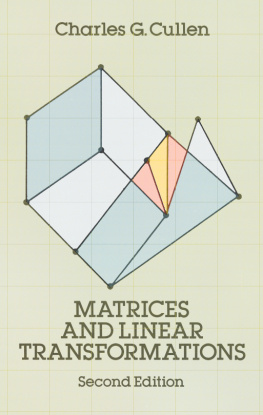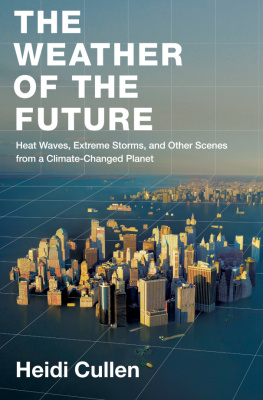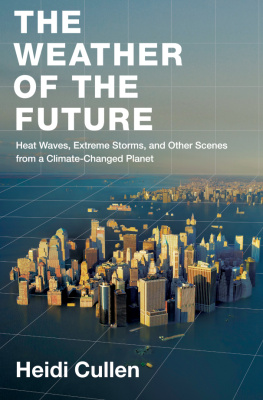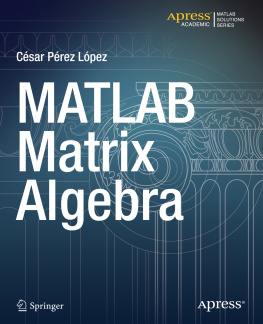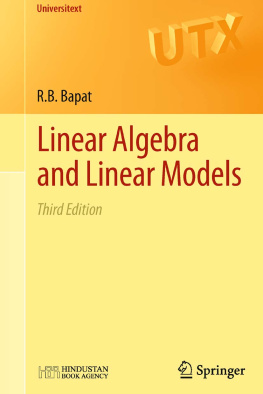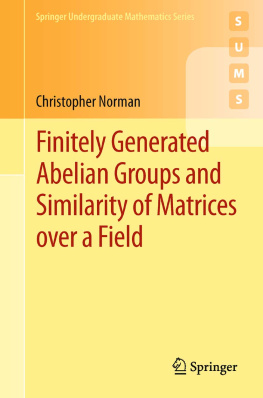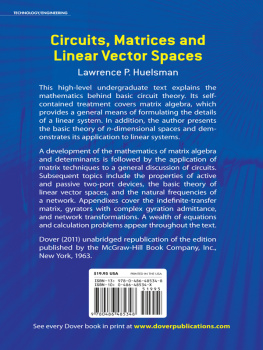Cullen - Matrices and Linear Transformations
Here you can read online Cullen - Matrices and Linear Transformations full text of the book (entire story) in english for free. Download pdf and epub, get meaning, cover and reviews about this ebook. City: New York;NY, year: 2012;1972, publisher: Dover Publications, genre: Home and family. Description of the work, (preface) as well as reviews are available. Best literature library LitArk.com created for fans of good reading and offers a wide selection of genres:
Romance novel
Science fiction
Adventure
Detective
Science
History
Home and family
Prose
Art
Politics
Computer
Non-fiction
Religion
Business
Children
Humor
Choose a favorite category and find really read worthwhile books. Enjoy immersion in the world of imagination, feel the emotions of the characters or learn something new for yourself, make an fascinating discovery.
- Book:Matrices and Linear Transformations
- Author:
- Publisher:Dover Publications
- Genre:
- Year:2012;1972
- City:New York;NY
- Rating:5 / 5
- Favourites:Add to favourites
- Your mark:
- 100
- 1
- 2
- 3
- 4
- 5
Matrices and Linear Transformations: summary, description and annotation
We offer to read an annotation, description, summary or preface (depends on what the author of the book "Matrices and Linear Transformations" wrote himself). If you haven't found the necessary information about the book — write in the comments, we will try to find it.
Matrices and Linear Transformations — read online for free the complete book (whole text) full work
Below is the text of the book, divided by pages. System saving the place of the last page read, allows you to conveniently read the book "Matrices and Linear Transformations" online for free, without having to search again every time where you left off. Put a bookmark, and you can go to the page where you finished reading at any time.
Font size:
Interval:
Bookmark:
MATRICES
AND
LINEAR
TRANSFORMATIONS Second Edition CHARLES G. CULLEN
University of Pittsburgh DOVER PUBLICATIONS, INC., NEW YORK Copyright 1972 by Charles G. Cullen.
All rights reserved. This Dover edition, first published in 1990, is an unabridged, corrected republication of the second edition (1972) of the work originally published in 1966 by Addison-Wesley Publishing Company, Reading, Massachusetts. Library of Congress Cataloging-in-Publication Data Cullen, Charles G. Matrices and linear transformations / Charles G.
Cullen.2nd ed. p. cm.(Addison-Wesley series in mathematics) ISBN-13: 978-0-486-66328-9
ISBN-10: 0-486-66328-0 1. Matrices. 2. Title. II. Series. Series.
QA188.C85 1990
512.9'434dc20 89-25677
CIP Manufactured in the United States by Courier Corporation
66328008
www.doverpublications.com Preface
to the
First
Edition This textbook was originally developed for a one-term course in linear algebra and matrix theory, which is offered each term at the University of Pittsburgh. The students are mostly sophomores and juniors majoring in mathematics, engineering, and the physical sciences. In addition, the course regularly attracts freshman honors students as well as graduate students from the departments of economics, public health, philosophy, education, as well as engineering and the sciences. My major purpose in writing this book was to provide a text, requiring a minimum number of prerequisites, which would enable me, in a one-term course, to cover these topics which are most frequently encountered in physical applications. In addition to the standard material on systems of linear equations, I wanted to include a fairly complete treatment of the characteristic value problem, including a discussion of normal matrices, and culminating with a discussion of the Jordan canonical form. Chapters provide such a text.
For the first seven chapters only a first course in calculus and analytic geometry is required and it is possible to study them simultaneously. The major objects of study are matrices over an arbitrary field. Vector spaces are introduced not only to help with this study but also because they are of great interest in their own right. Even at the beginning level I have decided to give the abstract definition of a vector space and to establish the isomorphism of such systems to n-tuple spaces. Linear transformations on finite dimensional vector spaces are introduced to provide a fruitful geometric interpretation for the study of similarity of matrices and a geometric motivation for the characteristic value problem. The connection between matrices and linear operators is treated extensively, but when a choice exists I have normally given the matrix result first and then interpreted it as a result about linear operators.
A notable exception is , he should have developed sufficient insight to be able to handle the more abstract development given there. Chapters . The most complete picture of the canonical forms for similarity is provided by taking both paths to the Jordan canonical form. Unfortunately there is seldom time for both treatments in a one-term course. If a two-term sequence is given, it is certainly worthwhile to give both developments. Chapters provide introductions to matrix analysis and numerical linear algebra respectively.
These chapters are by no means complete and are intended only to sample two interesting and important areas of further study. Parts of these last two chapters require the student to have completed the normal calculus and differential equations sequence. Several topics are included which do not normally appear in elementary texts. Notable among these are the detailed discussion of commutativity in . Both of these sections can be omitted during a first reading. Those sections which are not in the main line of the development are marked with an asterisk.
Although this book was primarily intended as a text for a one-term course, I have included enough material for a two-term sequence. In this case all of the text material can be covered and the instructor may have enough time left to cover one or two of his favorite topics, which I have omitted. In addition to Chapters optional), there are several rearrangements of the text material which would be suitable for one-term courses. Among these are: I. Chapters optional). (For those who prefer to concentrate on matrix theory, keeping linear transformations and vector spaces in the background.) II.
Chapters will be a review.) III. Chapters optional). IV.. Though mathematics is much easier to watch than to do, it is a most unrewarding spectator sport. Thus there are over 375 exercises for the students, which constitute an integral part of the text. Many of these are numerical exercises designed to build skills and to illustrate the theory while others extend or complete the theory.
In many cases the exercises are designed to introduce the student to the topics to follow. Answers to the numerical exercises are included. The introduction of a certain amount of mathematical notation, mostly standard, is unavoidable and in fact desirable. To help the student overcome any initial difficulty with this symbolism I have included a glossary of mathematical symbols immediately preceding the main index. Many people have contributed to the preparation of this book and I am indeed grateful. The Department of Mathematics at the University of Pittsburgh, under Professor Mario Benedicty, has generously supplied the necessary secretarial assistance and underwritten the cost of the first preliminary edition.
Miss Nancy Brown and Miss Grace Merante carefully typed all the preliminary versions and their patience and cooperation is gratefully acknowledged. Several of my colleagues have offered valuable and constructive criticism, which has been most helpful. I particularly want to thank Professors Herbert Gindler, George Byrne, and Louis Sacks. Several graduate students at the university have been most helpful and I would particularly like to thank Ralph Carlson, Catherine Falk, David Hott, and Allen Schweinsberg. My biggest debt is to the several hundred students at the University of Pittsburgh who have acted as guinea pigs for the preliminary versions of this book. May 1966 Preface
to the
Second
Edition The basic treatment of the subject in this edition is unchanged from that in the first edition, although many developments have been clarified and expanded to accommodate the reader for whom this is a first exposure to abstract mathematics. May 1966 Preface
to the
Second
Edition The basic treatment of the subject in this edition is unchanged from that in the first edition, although many developments have been clarified and expanded to accommodate the reader for whom this is a first exposure to abstract mathematics.
Many more illustrative examples have been included, and the number of exercises has been substantially increased. I have also tried to include more road signs; to tell the reader where he should be and where the development will take him if he follows along. There has been a major change in notation from the first edition. At first glance the expert may not like the new notation, but it has been my experience that the students learn it easily and accurately and can transfer to other notation later without difficulty. The original motivation for the changes came from the success students have in learning the compiler languages (e.g. Fortran) used to communicate with modem digital computers.
The treatment of metric concepts in Euclidean and unitary spaces has been increased. Proofs of the Cauchy-Schwartz and triangle inequalities have been included and the treatment of orthogonality has been substantially improved. The number of inductive proofs has been increased and there is a greater use of mapping diagrams and lattice diagrams to help the reader visualize the various complicated situations which arise. I am indebted to the many users of the first edition who have communicated to me their suggestions for improving the text.
Next pageFont size:
Interval:
Bookmark:
Similar books «Matrices and Linear Transformations»
Look at similar books to Matrices and Linear Transformations. We have selected literature similar in name and meaning in the hope of providing readers with more options to find new, interesting, not yet read works.
Discussion, reviews of the book Matrices and Linear Transformations and just readers' own opinions. Leave your comments, write what you think about the work, its meaning or the main characters. Specify what exactly you liked and what you didn't like, and why you think so.

